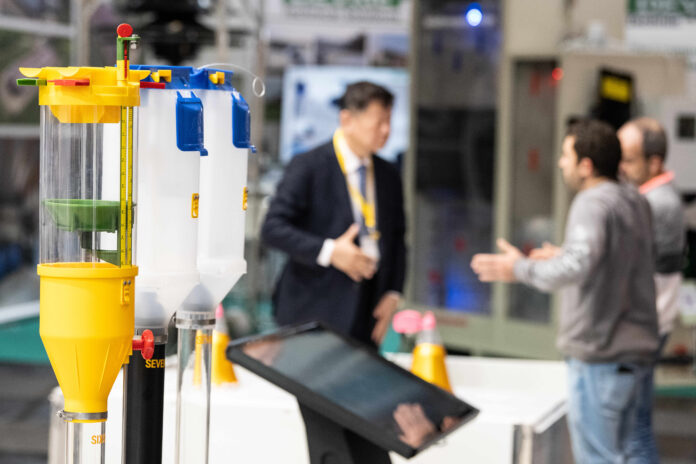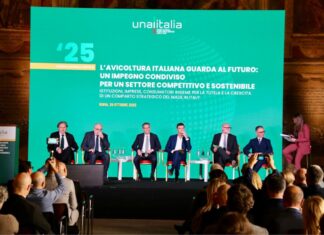
As in previous years, poultry farmers are currently facing a number of challenges. These include, in particular, a further improvement in animal welfare and animal health, as demanded by politicians and society. In terms of animal health, they must continue to focus on the highly contagious bird flu (avian influenza). Reducing antibiotic use and emissions from poultry farming is also on the to-do list of many companies. And last but not least, poultry farmers have to cope with higher feed and energy prices. The trends shown are reflected in the innovations in the poultry sector at EuroTier 2024. In addition to innovative developments for improving animal health, exhibitors will also be presenting innovations for rearing and for laying hen facilities.
Dr. Christiane Keppler, Landesbetrieb Landwirtschaft Hessen (LLH – Hesse State Framing Authority)
Laying hens are kept for significantly longer
In laying hen farming, considerable efforts have been made to raise the birds with an intact beak and at the same time to improve animal welfare. In order to compensate for the high rearing costs, laying hens are and will continue to be kept for significantly longer. This can be achieved by breeding for longer persistence of laying and by improving animal health and management.
Innovations for improving animal health
This year, a number of innovations were introduced to improve animal health, and these were honoured with a total of five medals.
Significant further development in poultry vaccination
Optimising vaccination success while also improving animal handling is an important prerequisite for a long lifespan and for avoiding vaccination damage. Two innovations were honoured in this context: For example, Agri Advanced Technologies (AAT) has developed Vaccybot, the first fully automated breast vaccination process for poultry. It is a new development that revolutionises poultry vaccination in terms of accuracy and vaccination success. The system enables the simultaneous injection of up to six different vaccines with unprecedented precision and speed, without the need to hold the animals in place by hand. This innovation was therefore awarded gold. The MultiVacc vaccination machine from Big Dutchman International is the first semi-automatic vaccination machine that can simultaneously administer four chest and one wing vaccination in an animal-friendly way, by manually catching the birds and holding them in a certain position against the device. It was therefore awarded silver. Both vaccination methods represent a significant advancement in the field of poultry vaccination and offer major improvements with regard to function and procedure.
Fighting red bird mites without chemicals
The red mite is found worldwide in poultry barns, especially in laying hen operations. If the number of mites increases dramatically, animal health and profitability are severely affected. The new technology of the EX Cold Plasma Mite Trap from MIK International uses a mite trap to combat mites by exposing the parasites to a cold atmospheric pressure plasma. This could reduce the use of acaricides, silicates or antiparasitics in the future and significantly improve animal health and economic efficiency. A gold medal was awarded here as well.
Higher disinfection performance for hatching eggs
Hygiene during the hatching process is also an important factor for the animal health of poultry. The eggytizer from Agri Advanced Technologies (AAT) uses electron beam sterilisation technology (eBeam) to disinfect hatching eggs. The process enables a higher level of disinfection than conventional methods and, in initial trials, showed a better hatching rate. The use of this technology is expected to improve chick health and provide an economic advantage while eliminating the need for chemical disinfectants. The eggytizer was therefore awarded silver.
Enhanced washing robot for aviaries
Cleaning and disinfecting laying hen coops is a challenge due to the complex and irregularly shaped facilities on different levels. When cleaning manually, some areas are difficult to reach, which means a lot of work and cleaning results that are not always satisfactory. The Sharky 430 from Big Dutchman International is an advanced washing robot for cleaning rearing and laying hen coops with aviary systems. The well-known washing robot has been extended by a very flexible washing arm that makes it possible to reach all areas in an aviary. This advancement was awarded silver.
Improved animal welfare for laying hens
Raising laying hens with intact beaks and optimally preparing them for the conditions in the laying aviary is a challenge. The Vencomatic Group has improved its well-known Bolegg Starter Breeding Aviary for this purpose. Big Dutchman International went one step further by combining the well-known Natura Nova Laying Aviary with a rearing aviary in which hatching is even possible in the coop. The hens can remain here from hatching until the end of the laying phase, do not have to be transported and do not have to become accustomed to a new system and a new coop. This system could significantly reduce the stress on the animals and contribute to greater animal welfare.
Ergonomic perch
Perches are an important element in laying hen farming systems, as the birds use them for roosting at night and for resting during the day. They must also provide a good grip to ensure safe landing. The company BARKU Barnsdorfer Kunststofftechnik has developed a new ergonomic plastic perch for laying hens that is flattened at the top and has ridges to prevent hens from slipping off when they fly up to it. In addition, the perch is made from recycled, high- quality plastic.
Larval snacks for chicks
In the first few weeks of life, chickens naturally eat mainly insects and worms. In order to keep the animals occupied and at the same time provide them with high-quality protein, the company WEDA Dammann & Westerkamp has developed ‘ProBar – The Larvae Snack Bar’ for poultry. Here, a few live larvae are gently dispensed at specific time intervals.
Summary
Five medals will be awarded for innovative developments at EuroTier 2024 that aim to improve the health of poultry. These innovations, along with other developments that have the potential to improve animal welfare, are continuing the trend of recent years towards improving poultry farming while also facilitating labour management and increasing occupational safety.
Source: EuroTier

















